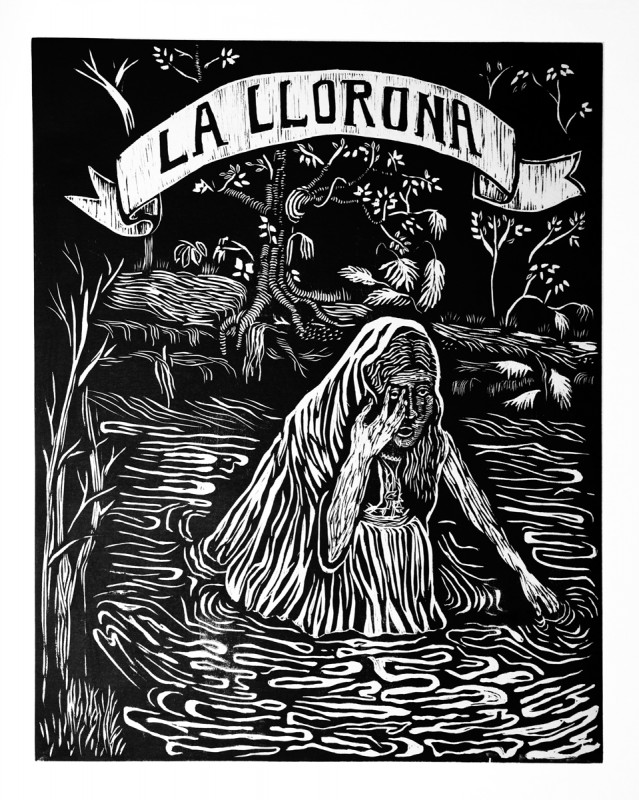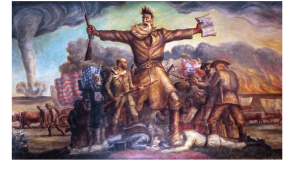There she is, hair black as night with a dress on as white as snow, but for some reason you can’t get a good view of her face. Then, all of sudden, she’s in yours, screaming at the top of her lungs. This is not your typical girl, and although she may sound like one, she is much worse. What you just witnessed is a mother grieving for her children. Some might question her parental instincts, but she only killed them for love, and let’s be honest, love makes you do some crazy things. If you are wondering who I am talking about, the woman I am referring to is La Llorona, who also answers to the name weeping woman.
The story is about a beautiful lady who fell in love with a man. They got married and had children, but sadly the husband died and left the lady to raise their children alone. Even with the struggles of raising her children alone, she found love again with another man. Everything was going great between them, until he found out that she has children. Furious with her, he left her for another woman. Anger and despair filled her heart and her mind, so she blamed her children for ruining what she wanted the most. She believed that if she could get rid of the children, he would come back to her. So she took her children to the river, where she drowned them. But shortly after she realized what she had done, she became horrified at herself. With a broken heart, forever after she then went on in life, mourning for the loss of her children. After her death, it is said that she lures people away to kill them in the hope of finding her lost children.1

This story dates back for centuries, starting before the Spanish Conquest. During that time period, the story is that an Aztec emperor had heard a woman’s cries and asked a nearby priest what it meant. The priest replied, saying that the cries were from the goddess Cihuacoatl, and her cries were one of the eight omens of doom. These omens began manifesting during the ten years before the arrival of Cortes in 1519. Cihuacoatl is the Aztec goddess who supposedly steals children away from their mothers and fathers, then later on sacrifices them.2
In other related stories of La Llorona, the woman isn’t known as La Llorona, but rather as La Malinche, the Indian mistress of Cortes. In this version, she doesn’t weep because of the loss of her children, but instead weeps because she betrayed her people to the conquerors.3 Cortes was the Spanish conquistador and Malinche was sold to him as a slave, but over time she was willing to help him on several adventures, but by doing this, she turned against her people. Although no known children were killed, she does appear to have had children with Cortes. This is where the origins of the legend gets confused on which culture actually created La Llorona. There are rumors saying that the Spanish may have gotten the origins confused with one of their own native legends.4 Regardless of where the story was first heard, the documentation of La Llorona appeared around 1550.5 Over time, the myth of La Llorona has been adapted to different customs and traditions, but each adaptation continues to recount five stable elements: a woman, a white dress, weeping for lost children, wandering, and water.
In other versions of the story, Llorona is simply a woman who drowns her children. English-language versions of the story simply call the woman the weeping woman, with her white dress symbolizing her link to the spiritual world as a ghost. In most of her stories, children do die; therefore, she weeps for them regardless of how they may die. While wandering and water are separate story elements, they go hand in hand in each adaptation. The Weeping Woman will always be wandering to find her drowned children, no matter where the story is told. This is why parents in the American south-west ( in California, Arizona, Colorado, Texas, and Mexico) warn children not to stray away, be naughty, or go out after dark, because they believe if the Weeping Woman is out there wandering, she could find you.6 Not only does she wander everywhere, but she typically will wander near bodies of water. This creates yet another warning that parents impart to their children, believing that water is dangerous and unpredictable. To prevent children from going near water without an adult, they tell their children the tale of La Llorona.
But it’s not just children that she goes after, but rather everyone. Typically, it’s more common for her to go after men than women, because it was a man who drove her to kill in the first place. So she uses her broken heart to get revenge on men because of how betrayed she feels.7 She uses her weeping to lure men to her, then kills them shortly afterwards. Since it is more common for males to be lured away, there are lessons for boys, namely, that the tale suggests to boys that women are temptresses of malevolent sexuality that can cause them to lose their souls as well as control of their bodies.8 While women aren’t primarily targeted, La Llorona can also teach young girls lessons as well, namely, that girls should be careful not to fall for a young man who may have wealth and nice clothes, but who is too far above them to consider marriage.9 Although it may seem unfair to women, overall the tale is meant to protect young ones from disobedience and to guide them in proper behavior. Since the story revolves around a woman, it is common for mothers and grandmothers to tell the Weeping Woman tale. Since the story is more typically shared by women rather than men, women used this to create an adaption in La Lloronas tale. Most females believe that La Llorona is a fragile woman, giving the impression that females are victims. So by evolving her story, they can adapt La Llorona to seem strong and powerful.

In Seguin, Texas you will find a place called Woman Hollering Creek, which crosses Interstate 10 near San Antonio, Texas. It is here where the story changes from one depicting a grieving mother to a survivor. In this version, the woman is a young bride in a white dress. But instead of being left behind by a man, she is beaten and has a miscarriage. The creek goes along her house, so she wanders along it while her husband is away at work. Later on in her life she gives birth, and it was at that point where she conjures up images of La Llorona.10 In this version, it still manages to have all the key elements of La Lloronas story. The white dress because she is a female bride, the weeping for children because she had a miscarriage, the Woman Hollering Creek being her source of water while wandering around it. However, instead of weeping and longing for children for eternity, she uses her voice in other ways. The Woman Hollering Creek story has her gaining her voice as a sign of rejection from domestic abuse. Although it may be completely different from most known stories, this one has became popular in the female world. With La Lloronas’ legend, women experience a sense of feeling trapped because of their lack of control. But in the Woman Hollering Creek version, instead of luring people to their death or seeking vengeance for a violent husband, the woman simply lives her life. She doesn’t cave in to a dangerous mind, but rather show that she’s stronger than that.
Adaptations of these stories will continue to change over time, sometimes making her a victim, sometimes a murderer, and sometimes a survivor. La Llorona may be an old myth, but her lessons and her stories continue. Keep this in mind the next time you misbehave, or wander alone, or go near water, because you never know when you might stumble upon a beautiful lady searching for lost children.
- Celebrating Latino Folklore: An Encyclopedia of Cultural Traditions, 2012, s.v. “La Llorona (The Wailing Woman),” by Leigh Johnson, 657. ↵
- Ana Maria Carbonell, “From Llorona to Gritona: Coatlicue in Feminist Tales by Viramontes and Cisneros,” MELUS 24, no. 2 (1999): 55. ↵
- Betty Leddy, “La Llorona Again,” Western Folklore 9, no. 4 (1950): 365. ↵
- Celebrating Latino Folklore: An Encyclopedia of Cultural Traditions, 2012, s.v. “La Llorona (The Wailing Woman),” by Leigh Johnson. ↵
- Celebrating Latino Folklore: An Encyclopedia of Cultural Traditions, 2012, s.v. “La Llorona (The Wailing Woman),” by Leigh Johnson. ↵
- Bacil F. Kirtley, “‘La Llorona’ and Related Themes,” Western Folklore 19, no. 3 (1960): 155. ↵
- Bacil F. Kirtley, “‘La Llorona’ and Related Themes,” Western Folklore 19, no. 3 (1960): 156. ↵
- Celebrating Latino Folklore: An Encyclopedia of Cultural Traditions, 2012, s.v. “La Llorona (The Wailing Woman),” by Leigh Johnson. ↵
- Celebrating Latino Folklore: An Encyclopedia of Cultural Traditions, 2012, s.v. “La Llorona (The Wailing Woman),” by Leigh Johnson. ↵
- Celebrating Latino Folklore: An Encyclopedia of Cultural Traditions, 2012, s.v. “La Llorona (The Wailing Woman),” by Leigh Johnson. ↵



131 comments
Kerrie Hollihan
I’d like to get permission to use the La Llorona image in a trade publication. Do you know the source?
Thanks
Francisco Cruzado
Despite being hispanic, I remember my first encounter with La Llorona was the movie The Ring. I used to think that it was more of an American tradition, but this article certainly amazes me at tracing it back to even the well-known La Malinche and her sorrow for her bertraying of her people. It is true hence that culture is ever-changing, and ever-adapting. I do hope such a myth might continue to develop and enrich itself with many other different backgrounds. Great article!
Michael Thompson
This is an interesting article, as most Grimm fairytales were also made in order to teach young children life lessons, and so you could say this is just like any other folk tale, just originating in central America, rather than Europe. I never knew the full story, with her doing it for a man. I knew she drowned her kids, but never knew why, so this article was really informative in that regard.
Sebastian Azcui
Being hispanic I heard this story many times but I actually never knew where it came from and what is its origin. These type of myths or stories are poassed over generations and its amazing how this one went through over 500 years. Something interesting is how some things changed. I guess that depending on the place or the person that told the story changed some things like how La Llorona’s personality is and how she is.
Juan Arceo
Like mostly every other Mexican-American kid, I have at one point been told the story of La Llorona, and if that doesn’t traumatize/terrorize you for years to come, then this article will help out on that. It was interesting finding out about the different perspectives that this story has taken on such as the Malinche and the lady with the miscarriage. It amazes me that this story has been going around for so long, and I believe that this story will only continue to grow and be told for more years to come.
Jake Mares
This story is legendary to our state. Originally coming from north Texas which is less Hispanic, I remember my school teaching us this in both Spanish and history classes. While the roots of the story will always stick with me, I could not remember the difference in the versions as discussed in the article. But I will always know to run when you hear the cries late at night.
Gabriel Lopez
I haven’t heard of this story until last year during my Spanish class in high school. We were given this story as an assignment, and reading it gave me quite the chills. Reading more about it here and learning more about its origins was a pleasure, and it’s surprising to me how long this story has been passed down. I also heard of a recent movie about La Llorona that came out as of today, and I’m tempted to go see it now out of curiosity. Great article.
Trinity Casillas
The title caught my attention and I was pleasantly surprised to find out what it meant. I feel like I’m the only Mexican-American Texan born child who was never told this story when I was younger so I didn’t know it. I loved learning about the origins and differences in culture with the story. I also found it fascinating on why each culture or group changed it, like women making La Llorona a strong character not revolving her life around a man. I wish I could know how the story changes in the future and why.
Jesus Parker
Being a native Texan and a Hispanic I have heard this story countless times but I never wondered about the origin of this story. It is amazing how a simple myth is still going strong almost over 500 years! Along with the donkey lady and the railroad kids this legend will continue to be told for generations to come. There has not been one person who was born and raised in Texas who does not know about this legend which shows how stories can stand the test of time.
Roberto Rodriguez
I loved this article, it was not stretched out and not to short that I had too many questions either. I think that the beginning of the article was a very nice touch, equal amounts of creepy and interesting. My dad would always tell me and my sister these type of “urban legend” stories on road trips, so reading about the “Woman Hollering Place” near San Antonio made me think about my childhood a little bit. It also makes me want to take a couple friends up there on a Sunday drive and tell them this story. I thought that the title was a great hook for an even better article, I might just use the same title as this article if I ever do tell others this story.